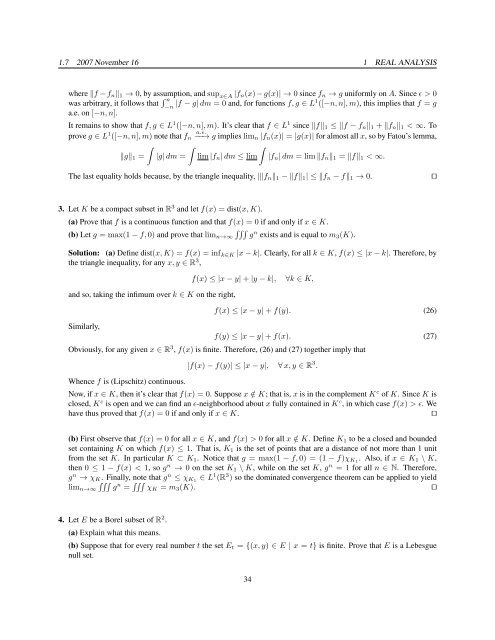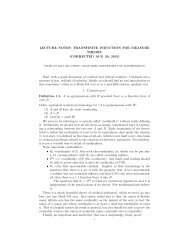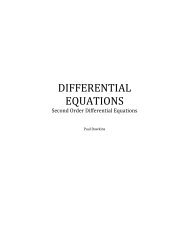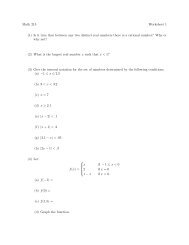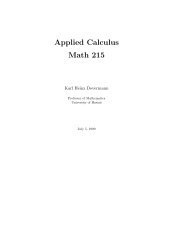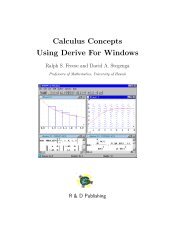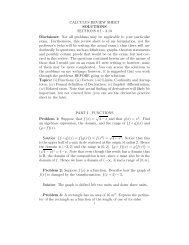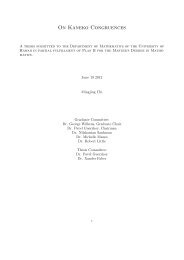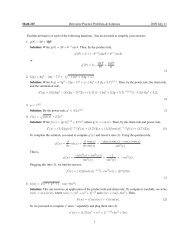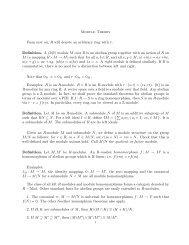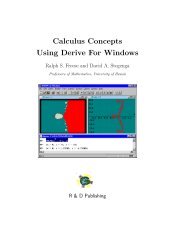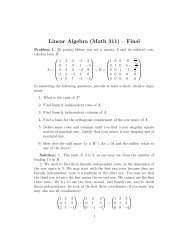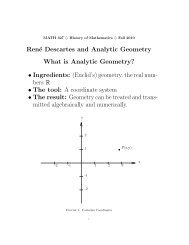Problems and Solutions in - Mathematics - University of Hawaii
Problems and Solutions in - Mathematics - University of Hawaii
Problems and Solutions in - Mathematics - University of Hawaii
Create successful ePaper yourself
Turn your PDF publications into a flip-book with our unique Google optimized e-Paper software.
1.7 2007 November 16 1 REAL ANALYSIS<br />
where f − fn1 → 0, by assumption, <strong>and</strong> supx∈A |fn(x) − g(x)| → 0 s<strong>in</strong>ce fn → g uniformly on A. S<strong>in</strong>ce ɛ > 0<br />
was arbitrary, it follows that n<br />
−n |f − g| dm = 0 <strong>and</strong>, for functions f, g ∈ L1 ([−n, n], m), this implies that f = g<br />
a.e. on [−n, n].<br />
It rema<strong>in</strong>s to show that f, g ∈ L1 ([−n, n], m). It’s clear that f ∈ L1 s<strong>in</strong>ce f1 ≤ f − fn1 + fn1 < ∞. To<br />
a.e.<br />
prove g ∈ L1 ([−n, n], m) note that fn −−→ g implies limn |fn(x)| = |g(x)| for almost all x, so by Fatou’s lemma,<br />
<br />
<br />
g1 = |g| dm = lim |fn| dm ≤ lim |fn| dm = lim fn1 = f1 < ∞.<br />
The last equality holds because, by the triangle <strong>in</strong>equality, |fn1 − f1| ≤ fn − f1 → 0. ⊓⊔<br />
3. Let K be a compact subset <strong>in</strong> R 3 <strong>and</strong> let f(x) = dist(x, K).<br />
(a) Prove that f is a cont<strong>in</strong>uous function <strong>and</strong> that f(x) = 0 if <strong>and</strong> only if x ∈ K.<br />
<br />
n (b) Let g = max(1 − f, 0) <strong>and</strong> prove that limn→∞ g exists <strong>and</strong> is equal to m3(K).<br />
Solution: (a) Def<strong>in</strong>e dist(x, K) = f(x) = <strong>in</strong>fk∈K |x − k|. Clearly, for all k ∈ K, f(x) ≤ |x − k|. Therefore, by<br />
the triangle <strong>in</strong>equality, for any x, y ∈ R 3 ,<br />
<strong>and</strong> so, tak<strong>in</strong>g the <strong>in</strong>fimum over k ∈ K on the right,<br />
Similarly,<br />
f(x) ≤ |x − y| + |y − k|, ∀k ∈ K,<br />
f(x) ≤ |x − y| + f(y). (26)<br />
f(y) ≤ |x − y| + f(x). (27)<br />
Obviously, for any given x ∈ R 3 , f(x) is f<strong>in</strong>ite. Therefore, (26) <strong>and</strong> (27) together imply that<br />
Whence f is (Lipschitz) cont<strong>in</strong>uous.<br />
|f(x) − f(y)| ≤ |x − y|, ∀ x, y ∈ R 3 .<br />
Now, if x ∈ K, then it’s clear that f(x) = 0. Suppose x /∈ K; that is, x is <strong>in</strong> the complement K c <strong>of</strong> K. S<strong>in</strong>ce K is<br />
closed, K c is open <strong>and</strong> we can f<strong>in</strong>d an ɛ-neighborhood about x fully conta<strong>in</strong>ed <strong>in</strong> K c , <strong>in</strong> which case f(x) > ɛ. We<br />
have thus proved that f(x) = 0 if <strong>and</strong> only if x ∈ K. ⊓⊔<br />
(b) First observe that f(x) = 0 for all x ∈ K, <strong>and</strong> f(x) > 0 for all x /∈ K. Def<strong>in</strong>e K1 to be a closed <strong>and</strong> bounded<br />
set conta<strong>in</strong><strong>in</strong>g K on which f(x) ≤ 1. That is, K1 is the set <strong>of</strong> po<strong>in</strong>ts that are a distance <strong>of</strong> not more than 1 unit<br />
from the set K. In particular K ⊂ K1. Notice that g = max(1 − f, 0) = (1 − f)χK1 . Also, if x ∈ K1 \ K,<br />
then 0 ≤ 1 − f(x) < 1, so g n → 0 on the set K1 \ K, while on the set K, g n = 1 for all n ∈ N. Therefore,<br />
g n → χK. F<strong>in</strong>ally, note that g n ≤ χK1 ∈ L 1 (R 3 ) so the dom<strong>in</strong>ated convergence theorem can be applied to yield<br />
limn→∞<br />
g n = χK = m3(K). ⊓⊔<br />
4. Let E be a Borel subset <strong>of</strong> R 2 .<br />
(a) Expla<strong>in</strong> what this means.<br />
(b) Suppose that for every real number t the set Et = {(x, y) ∈ E | x = t} is f<strong>in</strong>ite. Prove that E is a Lebesgue<br />
null set.<br />
34


